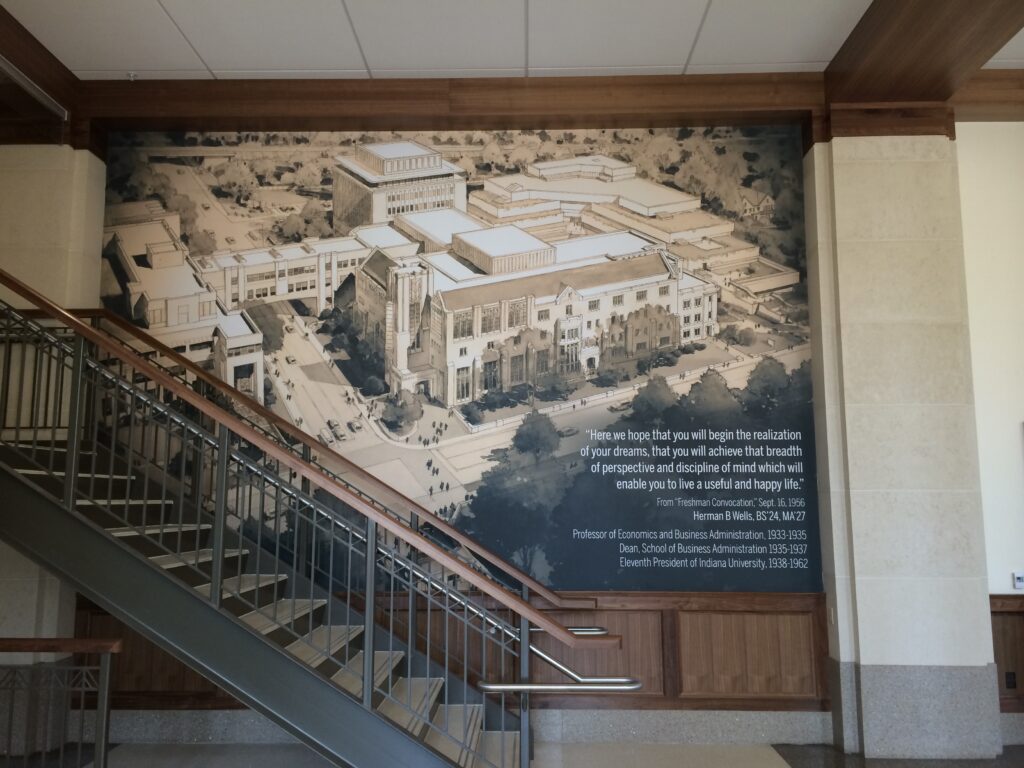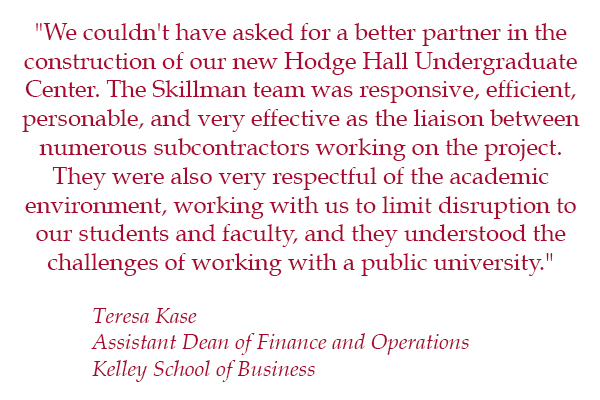Higher education building projects are some of the most complex building projects. They generally involve multiple stakeholders, strict timelines and budgets, outdated infrastructure, and, of course, thousands of students and faculty.
Having a good construction manager on your team can pave over many of the bumps and roadblocks that come up as you navigate your higher education building project. The construction manager’s preparation begins with asking the right questions. When Skillman began work on a multi-phase expansion and renovation for the Indiana University Kelley School of Business, we asked a lot of questions, knowing that the answers would guide the project over the next five years. Here’s what we asked:
There are many stakeholders—how do we communicate with everyone?
This question requires several pre-requisite questions: Who are the stakeholders? What do they need to know? How often? And what is the best way to reach them? Because every stakeholder is different, each project requires a unique communication plan.
At IU, Skillman coordinated with many university groups and used a variety of communication methods to help stakeholders make decisions and stay informed. Within this project were various owners, architects, engineers, and subcontractors, all of whom needed to provide input at different points in the project. To keep communication running smoothly—which is crucial to the success of the project itself—Skillman delivered monthly reports, weekly progress meetings, punchlist reports, constructability review notes, project change orders, and digital scans to the right parties at the right time. An online document management system also provided 24/7 access to project information.
How can we anticipate and manage changes without derailing the budget and schedule?
Changes and change orders are always part of the design and construction process, and how they are managed can significantly impact the project scope, schedule, and budget. For IU, Skillman uses a variety of tools, including BIM modeling, to develop solutions and has appointed a dedicated BIM Manager. By proactively looking for “conflicts” in the project plan, potential solutions can be identified before the conflict ever arises. The earlier this is done, the smaller the cost associated with the change or possibly no cost impact at all.
It is often difficult to really understand what impact a change may have—how would a different finish look in a space? Would re-routing ductwork interfere with something else? Skillman’s BIM manager uses tools such as Revit and Navisworks software to work with project stakeholders to visualize the solutions. This helps stakeholders make informed decisions about what changes are most practical within the scope of the project and budget.
When the IU Kelley project was in progress, for instance, there was a question of how colors should be used on the building’s classroom walls. Skillman’s Project Engineer and BIM Manager Brandon Wolf worked closely with the decision makers to give them a more complete idea of their options. Wolf visited each classroom in question and then created a digital rendering of what the options would look like in the space. As a result, the decision makers at IU Kelley selected an option they had not initially considered.
How will noise be managed?
Along with construction comes noise, which conflicts with student studies and staff instruction. But when you identify the noise-generating activities (e.g., nailing stud walls) within your plan and know their proposed timeline, you can schedule them accordingly, ideally as second-shift activities.
Coordinating this well in advance saves money in two ways. It allows those second-shift activities to be identified in the bid documents so contractors can accurately plan and budget. It also gives the school the opportunity to plan which classrooms will be in use and when before the semester starts.
How will safety be maintained on an active campus?
There are myriad concerns wrapped up in this question, not the least of which is student safety as they travel to and from class around construction work. As Construction Manager, Skillman coordinates with the school to locate temporary partitions, construction barriers, and directional signs that also take foot and street traffic into consideration. This may include installation of sidewalks and covered walkways, as well as emergency exit access points. In addition, construction management coordinates background checks and drug tests and provides clearly visible project ID for construction personnel, because student safety is not just a matter of avoiding flying debris.
What are the client goals that must be top priority in every decision?
A Construction Manager’s primary responsibility is to act as the owner’s advocate. Each and every discussion should further the owner’s goal. For Skillman’s work with Indiana University, those goals included: providing modern spaces that encourage student interaction, respecting the history of the Kelley School of Business, ensuring the best future for it with a sustainable facility and achieving those goals on schedule and within budget.
We’re particularly proud of how Skillman helped IU Kelley pursue those goals through the use of reclaimed wood in the new building. To minimize the loss of the trees that had to be removed from the new site, Skillman worked with the contractor to identify trees that could be used to create architectural casework and flooring. Working alongside the interior designer, we then recommended that the reclaimed wood actually be used as a veneer for the flooring, which would enable the reclaimed wood to be visible across a larger surface area. It’s a small detail in the grand scheme of things, but it was an important part of preserving the school’s heritage as well as promoting responsible environmental practices as the school looks to the future.
“At the end of the day,” said Brandon Wolf, “We’re there to protect the owner and the owner’s interests. We’re there every day looking out for the end result, because our goal is to make something exactly the way they were thinking it should be.”




